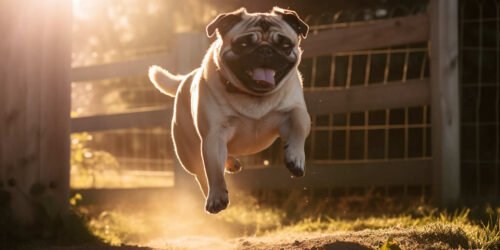Can Pugs Be Guard Dogs?
Introduction
It’s a question many pug enthusiasts grapple with: “Can my loveable, friendly pug actually guard my home?” If you’re among the curious, I’ve been in your shoes. While research demonstrates that Pugs rank low as guard dogs at around 2 out of 5, they do have an unexpected quality – their alertness makes them well suited to be watchdogs.
In this blog, we will delve into the nuances of Pugs as watchdogs versus guard dogs and share some handy tips on how to train your Pug for maximum alertness. Ready to unravel this canine conundrum? Let’s go!

Table of Contents
Key Takeaways
- Pugs are not considered ideal guard dogs due to their small size and physical limitations.
- Instead, pugs excel as watchdogs, utilising their alertness and protective nature to warn owners of potential threats.
- Training pugs for effective watch dog behaviour involves socialisation, obedience training, and teaching them the “bark” command.
- Positive reinforcement is recommended when training pugs, using rewards such as treats, praise, and toys to encourage desired behaviours.
Can Pugs Be Guard Dogs?
Pugs may not be able to protect an area or attack intruders, but they can still serve as effective watchdogs due to their alertness and protective nature.
Watchdog vs. Guard Dog: Understanding the Difference
Let’s talk about the distinction between a guard dog and a watchdog because it can be quite confusing. A guard dog is primarily trained to protect an area or people from potential harm by using their physical abilities.
They’re often large, robust breeds capable of taking action against intruders if needed. On the flip side, a watch dog, isn’t expected to physically confront threats; instead, they serve as living alarms.
Their main job is to alert their owners of any unexpected or suspicious activities occurring in the surroundings.
Pugs fall more comfortably into the watchdog category according to expert trainers who rate them low for guard dog abilities but recognize their worth as reliable alarm systems – thanks largely due to their tendency to bark at noises.
However, one shouldn’t mistake this barking trait for aggression; pugs are known for being friendly “couch potatoes” rather than fearsome protectors!
Pugs as Watchdogs: Their Alertness and Protective Nature
Pugs are often labelled as “clowns of the canine world” due to their jovial nature and constant desire for play. But did you know these playful little furballs can also play a role in home security? Pugs possess an innate alertness which allows them to quickly react to potential threats.
They are known for their heightened ability to sense changes, making them highly attentive watch dogs.
Don’t be fooled by their small size or the friendly wag of their curled tails. These pint-sized pups make reasonably good watch dogs with moderate barking tendencies that serve as alarm systems when strangers approach your space.
Their protective instincts kick in around loved ones and territory, possibly deterring unwanted intruders from infringing on your peace at home. While they may not have the physical strength of larger breeds, they compensate with their vigilance – an unexpected trait rolled into a bundle of joy we call pugs!
Limitations of Pugs as Guard Dogs: Size and Physical Abilities
Let’s dive right into the limitations that make pugs less than ideal as guard dogs. To start, their size poses a significant challenge. This breed is relatively small, with an average weight that is generally not intimidating to intruders or threats.
Their petite stature merely underscores their primarily bred purpose – companionship, not guarding.
Furthermore, Pugs physically lack what it takes to be effective guard dogs due to certain health conditions associated with them. The flat faces they’re well-known for can lead to respiratory issues making them unfit for strenuous tasks such as chasing down potential threats or standing on their feet all day long patrolling an area.
Even the Royal Veterinary College recognizes these health issues as severe enough to consider them no longer “typical” dogs! It’s these physical abilities – or rather the lack of them – that put Pugs at a disadvantage when considering if they can be guard dogs.
Training Pugs to be Watchdogs
To train Pugs to be effective watchdogs, it is important to focus on socialisation, obedience training, and teaching them the “bark” command.
Socialisation and Obedience Training
- Socialisation: Introducing your Pug to various people, animals, and environments starting from a young age is crucial. This helps them develop good manners and reduces their tendency towards aggression or fearfulness. By exposing them to different situations, you can help them become more confident and well-behaved.
- Obedience Training: Teaching basic commands such as sit, stay, come, and down is vital for effective communication with your Pug. Obedience training provides mental stimulation and helps establish you as the pack leader. Additionally, teaching your Pug to walk on a leash without pulling ensures better control in public spaces.
- Positive Reinforcement: Use rewards like treats, praise, or playtime to reinforce desired behaviours during training sessions. Pugs respond best to positive reinforcement rather than harsh punishment or negative reinforcement techniques.
- Consistency: Consistency is key in building good habits and preventing undesirable behaviours in Pugs. Establishing clear rules and boundaries consistently will help your Pug understand what is expected of them.
- Consider Professional Help: If you’re unsure about how to train your Pug effectively or if you’re facing difficulties with certain behaviours, consider seeking guidance from a professional dog trainer who specialises in positive reinforcement techniques.
Teaching the “Bark” Command
One important skill to teach your pug is the “bark” command. This command can be useful in training your pug to become an effective watch dog. Here are some steps you can take to teach your pug to bark on command:
- Start by finding a trigger word: Choose a word such as “speak” or “bark” that you will consistently use as the command for your pug to bark.
- Use positive reinforcement: When your pug naturally barks, say the trigger word and immediately reward them with praise and a treat. Repeat this several times until they start associating the trigger word with barking.
- Use hand signals: Along with the trigger word, use a hand signal like pointing at them or holding up your hand, which will serve as another cue for them to bark.
- Practice and repetition: Set aside dedicated training sessions where you specifically ask your pug to bark using the trigger word and hand signal combination. Reward them each time they successfully comply with the command.
- Gradual fading of treats: As your pug becomes more proficient in responding to the bark command, gradually reduce the frequency of treats given as rewards. However, continue to provide verbal praise and occasional treats to reinforce their training.
- Consistency is key: Maintain consistency in using the same trigger word, hand signal, and training techniques during each practice session. This will help solidify their understanding of what is expected from them when given the command.
Positive Reinforcement and Rewards
Positive reinforcement training is highly encouraged when it comes to training pugs to be watch dogs or guard dogs. This type of training involves using rewards such as treats, praise, and toys to encourage desired behaviours. It’s an effective way to train pugs and can yield the best results.
- Rewards: Using rewards like treats, praise, and toys motivates pugs to learn and perform desired behaviours. These rewards should be given immediately after the desired behaviour occurs, so that the dog associates the reward with the action.
- Treats: Treats are a popular choice for rewards in training. Pugs are food-motivated, so high-value treats can be especially effective in getting their attention and reinforcing good behaviour.
- Praise: Verbal praise is another important aspect of positive reinforcement training. Pugs thrive on attention and love to please their owners, so enthusiastic praise can go a long way in motivating them.
- Toys: Some pugs may be more toy-motivated than food-motivated. Using their favourite toys as rewards can make training sessions more enjoyable for them.
- Timing: Timing is crucial when using positive reinforcement. The reward should be given immediately after the desired behaviour occurs, so that the dog understands what they are being rewarded for.
- Consistency: Consistency is key in positive reinforcement training. Rewards should always be given for desired behaviours, while undesired behaviours should not be rewarded or reinforced.
- Patience: Pugs can be stubborn at times, so patience is essential during the training process. It may take some time for them to grasp certain commands or behaviours, but with consistent positive reinforcement, they will eventually catch on.
- Punishment: The use of punishment should be avoided when training pets, including pugs. Positive reinforcement focuses on rewarding good behaviour rather than punishing bad behaviour.
Conclusion
In conclusion, while pugs may not possess the physical abilities or size to be effective guard dogs, they excel as watchdogs with their alertness and protective nature. It’s important to understand that there is a difference between a guard dog and a watchdog.
Pugs can still serve as excellent alarm dogs, alerting their owners to potential threats and providing companionship with their friendly and affectionate personalities. So, while they may not be the traditional choice for guarding an area, pugs bring their own unique qualities that make them beloved pets for many people.






